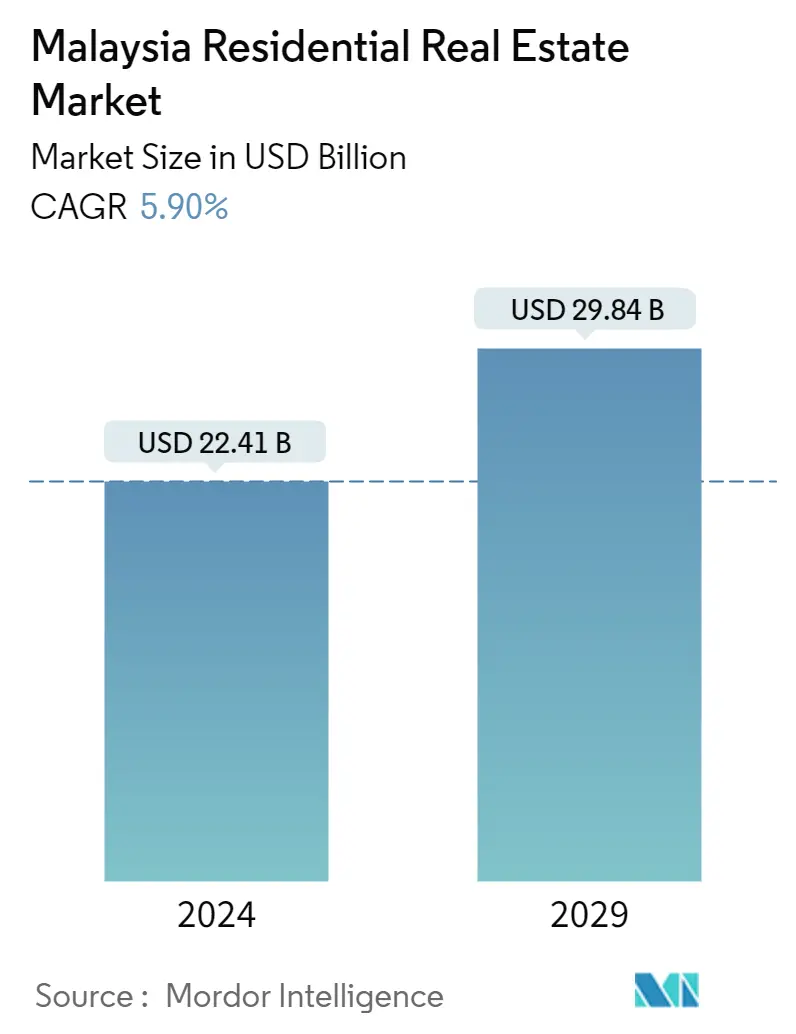Market Size of Malaysia Residential Real Estate Industry

| Study Period | 2020 - 2029 |
| Base Year For Estimation | 2023 |
| Market Size (2024) | USD 22.41 Billion |
| Market Size (2029) | USD 29.84 Billion |
| CAGR (2024 - 2029) | 5.90 % |
| Market Concentration | Low |
Major Players
*Disclaimer: Major Players sorted in no particular order |
Malaysia Residential Real Estate Market Analysis
The Malaysia Residential Real Estate Market size is estimated at USD 22.41 billion in 2024, and is expected to reach USD 29.84 billion by 2029, growing at a CAGR of 5.90% during the forecast period (2024-2029).
- In 2022, Malaysia's residential real estate market recovered with increasing demand skewed toward cheap housing. Due to the possibility of strong demand for residences among the young generation, the developers are cautiously optimistic about property prospects in the medium to long term.
- Malaysia's residential real estate market performed less well than projected in the first quarter of 2021. The resurgence of COVID-19 infections and the reimposition of strict Movement Control Order (MCO 2.0) requirements are two significant factors for the decreased performance.
- According to the Malaysia Property Market Index, the total median asking price in four main Malaysian markets (Kuala Lumpur, Selangor, Penang, and Johor) fell by -1.79% Y-o-Y in Q1 2021. Subsale residential property market saw high Y-o-Y demand growth of +19.2% in the first half of 2021.
- Increased innovation and a stronger focus on digital solutions are two good outcomes of a pandemic-stricken property business. By engaging with buyers through online activities, key property players have expedited their efforts to advertise products.
- Due to the inability to inspect properties in person due to the COVID-19 induced lockdowns, property buyers have shifted their focus to online browsing, fueled by substantial discounts offered by Malaysian developers for newly launched properties.
- Furthermore, the government's Home Ownership Campaign (HOC) was extended until December 2021. During Q1 2021, the total property market had a -5% Y-o-Y reduction in median asking prices. However, demand for subsale properties in Kuala Lumpur increased by 8.1% Y-o-Y in Q1 2021.
Malaysia Residential Real Estate Industry Segmentation
Residential real estate consists of housing for individuals, families, or groups of people. The report provides a complete background analysis of the Malaysian residential real estate market, which includes an assessment of the economy, emerging trends by segments and regional markets, significant changes in market dynamics, market overview, and company profiles.
Malaysia Residential Real Estate Market is Segmented by Type (Apartments and Condominiums and Landed Houses and Villas) and By Key Cities (Kuala Lumpur, Seberang Perai, George Town, Johor Bahru). The report offers market size and forecast in values (USD billion) for all the above segments.
| By Type | |
| Apartments and Condominiums | |
| Landed Houses and Villas |
| By Key Cities | |
| Kuala Lumpur | |
| Seberang Perai | |
| George Town | |
| Johor Bahru |
Malaysia Residential Real Estate Market Size Summary
The Malaysian residential real estate market is poised for significant growth over the forecast period, driven by increasing urbanization and a shift in population dynamics from rural to urban areas. The market has shown resilience, recovering from the setbacks caused by the COVID-19 pandemic, which had initially dampened performance due to strict movement control orders. The demand for affordable housing has been a key trend, with developers focusing on catering to the younger generation and low to middle-income groups. Government initiatives, such as the Home Ownership Campaign and the National Affordable Housing Council's efforts, have been instrumental in promoting affordable housing solutions, particularly in suburban and small town areas. The market's recovery is further supported by digital innovations and online property transactions, which have gained traction due to the pandemic-induced restrictions on physical property inspections.
The Malaysian government's commitment to urban development and infrastructure expansion is evident in its plans to construct a substantial number of affordable homes, targeting the bottom and middle-income earners. This aligns with the broader economic strategy outlined in the 12th Malaysia Plan, which focuses on addressing poverty and income disparities. The residential real estate sector is characterized by a fragmented market with numerous players, including prominent developers like SP Setia, IOI Properties, and UEM Sunrise. Recent strategic acquisitions, such as the merger of PropertyGuru and iProperty, highlight the growing importance of digital platforms in the real estate market. These developments, coupled with government support and a burgeoning middle-class population, are expected to drive the market's expansion, making it a dynamic and evolving landscape in the coming years.
Malaysia Residential Real Estate Market Size - Table of Contents
-
1. MARKET INSIGHTS
-
1.1 Current Market Overview
-
1.2 Residential Real Estate Buying Trends - Socioeconomic and Demographic Insights
-
1.3 Government Initiatives and Regulatory Aspects for Residential Real Estate Sector
-
1.4 Insights on the Size of Real Estate Lending and Loan to Value Trends
-
1.5 Insights on Interest Rate Regime for General Economy and Real Estate Lending
-
1.6 Insights on Rental Yields in the Residential Real Estate Segment
-
1.7 Insights on Capital Market Penetration and REIT Presence in Residential Real Estate
-
1.8 Insights on Affordable Housing Support Provided by Government and Public-Private Partnerships
-
1.9 COVID-19 Impact on the Market
-
-
2. MARKET SEGMENTATION
-
2.1 By Type
-
2.1.1 Apartments and Condominiums
-
2.1.2 Landed Houses and Villas
-
-
2.2 By Key Cities
-
2.2.1 Kuala Lumpur
-
2.2.2 Seberang Perai
-
2.2.3 George Town
-
2.2.4 Johor Bahru
-
-
Malaysia Residential Real Estate Market Size FAQs
How big is the Malaysia Residential Real Estate Market?
The Malaysia Residential Real Estate Market size is expected to reach USD 22.41 billion in 2024 and grow at a CAGR of 5.90% to reach USD 29.84 billion by 2029.
What is the current Malaysia Residential Real Estate Market size?
In 2024, the Malaysia Residential Real Estate Market size is expected to reach USD 22.41 billion.

